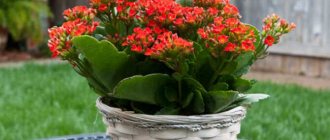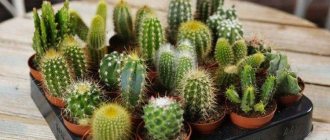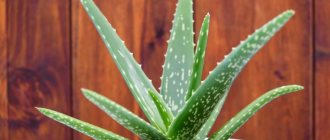Features of the plant
All types of Kalanchoe have common characteristics. Because succulents grow in the hot climates of Africa, Asia and South America, their leaves are adapted to store moisture and resemble thick pads. It is not for nothing that the family to which all Kalanchoe plants belong is called Crassulaceae.
Representatives of different species and varieties differ significantly from each other.
If Kalanchoe in a pot, as a rule, is a herbaceous plant or a small shrub, about 20 cm high, then in nature representatives of this family can grow up to two meters. The Kalanchoe flower can be red, yellow, orange, white, purple, pink, and vary in shape and size.
All are united by common features characteristic of Kalanchoe:
- fibrous, well-developed root system located in the top layer of soil;
- the stems are dense, juicy, completely covered with leaves;
- the fleshy leaves are dark in color;
- four-membered flowers are collected in panicle inflorescences.
Flowers can be erect or drooping, such as those of Kalanchoe mangina.
The flower of this type of Kalanchoe even in the photo looks fascinating. It is not surprising that this ampelous indoor plant is popular and loved among gardeners.
Fertilizer, top dressing
Kalanchoe does not really like various fertilizers. Just like in the matter of soil, the plant is quite unpretentious, but if you begin to notice that the flower lacks minerals, then choose succulent fertilizers. In winter, you should never fertilize the soil.
During this period, even if the Kalanchoe begins to wither (except for diseases), you should not overload the root system with various additives. The best time for feeding is the end of spring, or at least mid-summer. Fertilizers should be given half as much as indicated on the package - believe me, this amount will be more than enough for your home healer.
The only important rule when fertilizing is that the fertilizer mixture must be completely dissolved in warm water, then allow it to cool and only then add it to the soil. Otherwise, the root system will not be able to absorb the fertilizer.
KALANCHOE - HOME DOCTOR
Until the 60s of the last century in Europe there was practically no information about the medicinal properties of Kalanchoe, but as it began to enter indoor culture, reports of its medicinal properties began to appear. Thus, it was noted, for example, that by lubricating the nasal mucosa, the flu was quickly cured, and during the epidemic, people used it as a preventive measure. The juice of mashed Kalanchoe leaves stopped bleeding, quickly relieved toothache and headaches, and cured mastitis, eczema, and skin rashes. As a result of such reports, official medicine began to study this unusual plant. By the end of the 1960s, it was introduced into pharmacological practice as a treatment for long-term non-healing wounds and ulcers, fistulas and burns. True, it is worth noting that official medicine has focused only on the external use of plant juice, which cannot be said about traditional medicine.
It is not for nothing that this plant has received the status of the tree of life among the people. Kalanchoe juice has a pronounced anti-inflammatory, bactericidal, wound-healing, hemostatic effect, therefore it is used in the healing of ulcers, bedsores, wounds, burns, frostbite. Fresh Kalanchoe juice stops bleeding, treats boils, skin rashes, eczema, burns, cervical erosion, and cracked nipples. It not only destroys bacterial infection, but also exhibits antiviral activity. This juice is also effective for tonsillitis, periodontal disease, stomatitis..
Types and varieties of Kalanchoe
Kalanchoe flowers of different varieties differ greatly from each other in shape, size and color. Most decorative varieties of Kalanchoe are bred through selective breeding, which makes it easier to keep in the house and ensures long-term flowering.
Kalanchoe Benta
A subshrub that is cultivated in cold greenhouses. Grows up to a meter tall. Large rounded leaves resemble thick needles and grow up to 40 cm in length. The flowers are white, with a tube at the base of the corolla.
Feathery Kalanchoe (kalanchoe pinnata)
In nature, pinnate grows more than a meter in height, has a thick stem and large leaves. Indoor flowers of Kalanchoe pinnate are much smaller than their wild relatives.
This variety is the most popular, it is familiar to many, it is used for medicinal purposes. On the serrated fleshy leaves, “babies” grow along the edge, with which the plant reproduces.
With proper care, the plant produces a long arrow on which pink flowers resembling bells bloom.
Kalanchoe daigremontianum
The Degremona variety is similar to the pinnate variety, with the only difference being that its leaves are rounded and not elongated.
Kalandiva
How to care for Kalanchoe at home
Kalanchoe, which is quite easy to care for at home, has won people’s love and popularity for good reason. The main parameters that make up the care of Kalanchoe are: lighting, temperature and watering.
Since succulents grow in regions with hot climates, they need to maintain a microclimate close to natural. But it would be hard to call these indoor plants picky and capricious.
The soil
Growing Kalanchoe requires fertile and well-permeable soil. The best soil for Kalanchoe will be a mixture of turf and leaf soil, sand, peat and humus in equal parts.
The plant grows well in any universal soil mixture with the addition of peat , which can be bought in flower shops.
Store-bought succulent substrate is also great. It is necessary that the soil is slightly acidic or neutral.
Another option for a soil mixture for self-preparation: deciduous and turf soil, peat and sand in a ratio of 2:4:1:1. Peat can be replaced with coniferous soil. For epiphytic species, it is recommended to add a little humus to the soil. A good drainage layer should be placed at the bottom of the pot.
Bloom
How often Kalanchoe blooms depends on the conditions under which it is kept. By the whim of nature, Kalanchoe blooms in the autumn-winter period, when the air temperature is relatively low (at night about +70C, during the day - no higher than 150C), and daylight hours are short, 10 hours, no more. The plant blooms profusely on glassed-in loggias, but it is important not to overfreeze it: temperatures of +40C and below trigger irreversible processes in the leaves and stems and the flower dies.
To achieve year-round flowering, you will have to “lower” the air temperature and put the plant in the dark for 14 hours a day.
A freshly purchased flowering bush will not stop flowering if it is placed in partial shade and watered infrequently.
Faded buds need to be cut off, making room for new ones and preserving the aesthetic appearance of the Kalanchoe.
Watering in summer
How many times should I water Kalanchoe in summer? The dense, fleshy foliage of this plant can accumulate moisture inside, so the crop is perfectly capable of going without watering for several days without experiencing any discomfort. But with the arrival of summer, it is still necessary to pay a little more attention to the bush.
When answering the question of how much to water Kalanchoe in the summer, you should pay attention to the fact that the signal for this process will be the top dried layer of soil. If the soil is wet, then this activity should be postponed for a few more days.
Based on this, we can conclude that the soil is moistened approximately once a week, provided that the plant is kept at moderate summer temperatures. If the summer turns out to be hot, then watering is carried out every 3-4 days.
Living conditions depending on the season
The conditions of detention directly depend on what the owners want to get from the flower. If the goal is abundant flowering, then the Kalanchoe will have to be hidden in a dark room for one and a half to two months or covered with a dark film (simulating night) for 14 hours a day.
In addition, the air temperature should be close to autumn-winter (+7 at night and +15-16 during the day). Blooming Kalanchoe retains its appearance for several months in a row.
For the winter, the already rare watering is significantly reduced and fertilizing is not applied.
If there is no goal to achieve flowering, then the plant grows as usual, with the only difference being that the western or eastern window can be replaced with a southern one. Shoots that become very elongated due to insufficient winter light are pruned (Kalanchoe can be propagated with them).
Reproduction
There are several ways to propagate Kalanchoe: cuttings, leaves, seeds, “babies”, axillary buds and suckers.
Cuttings
Cuttings are one of the simplest and most popular methods of propagating succulents. Strong, healthy branches about 10 cm long are suitable for cuttings. The apical cuttings, pruned to give the bush a shape, take root well.
The lower leaves are removed from the cut shoot and the cut is cleaned.
- After 10-12 hours, the cuttings are rooted in soil for succulents, deepened by 2-3 cm, watered and left alone.
- The cuttings are placed in water or in a root growth solution (for a day), and then in water, in a warm, shady place. After the roots appear, the cuttings are planted in a pot with soil.
Leaves
Kalanchoe leaves root not only as well, but even better than cuttings. Fallen succulent leaves can be placed in a container with water, and when roots appear, transplanted into the ground. A fresh cut leaf easily takes root in the soil (it needs to be watered and covered with a jar or half a plastic bottle for 4-5 days).
Seeds
The seeds are scattered on the surface of the soil, without deepening them, lightly sprinkled with earth. Water with a thin stream of water, cover the container with a cloth or film and put it in a cool, shady place.
As soon as the sprouts hatch, they are picked and again covered with a transparent film with holes for air circulation. After several true leaves appear, the young shoots can be planted in pots.
Children
Some types of Kalanchoe form small outgrowths on the edges of the leaves, reminiscent of tiny leaves with roots - “babies”. Most often, the “babies” crumble into the ground when you touch the plant, germinate and produce young shoots, which are then replanted.
You can collect the “babies” and sow them in a separate pot for a permanent habitat.
Axillary buds
Axillary buds form in place of fallen leaves. They resemble a small head of cabbage and take root well when transplanted.
Offspring
Kalanchoe forms new shoots growing from the mother - offspring. When they reach 1/3 of the height of the main shoot, they can be transplanted into separate pots.
Signs of improper watering
Kalanchoe is not immune to the effects of pests and diseases, however, a gardener can minimize the likelihood of their occurrence, primarily by optimizing the watering regime. Lack of moisture, as well as its excess, negatively affects the condition of various parts of the plant, and the most popular problems associated with violation of soil moisture requirements are the following:
- Shredding of leaf blades and excessive stretching of the stem part. Most often, the cause of this phenomenon will be excessive moisture of the substrate in winter, especially if there is not enough light in the room with the flower. To eliminate the consequences of such a violation, it is necessary to increase the temperature, move the pot with the plant under the phytolamp and reduce the amount of irrigation liquid the next time it is used (after the soil has dried).
- The appearance of stem rot, which manifests itself in thinning shoots and darkening of the stem part: starting from the bottom and up to the very top. Treatment of Kalanchoe in this case will not bring the desired result, so all that remains is to cut off the healthy apical parts and root them to obtain a new plant, and the bush damaged by rot will have to be thrown away.
- Development of dropsy (Kalanchoe leaves become covered with swollen growths resembling blisters). The cause of this problem is prolonged waterlogging of the soil in the pot, so you will have to reduce the frequency of watering, trim off damaged parts and increase daylight hours.
- The appearance of dry and brown spots on the leaves, which over time grow over the entire surface of the leaf blade and lead to its death. To return the Kalanchoe to its former shape, you will have to cut off all the damaged leaves and revise the watering scheme, since the main reason for this phenomenon is considered to be prolonged drought.
- The appearance of white spots on the leaves. Usually the reason for this problem is spraying the flowerpot with cold and hard tap water, which means that to eliminate it you need to remove the damaged leaf plates and not repeat previous mistakes.
- Rotting of the root system and the appearance of mold on the surface of the substrate. Everything is simple here: the Kalanchoe was simply flooded, so you will have to remove the plant from the old pot and transplant it into a new one, having first removed all the damaged roots.
Maintaining an optimal watering regime for a plant is not as difficult a task as it seems to novice gardeners, and the main thing here is reasonable moderation, thanks to which all the listed troubles can be eliminated.
Diseases and pests
Diseases:
- Excessive air humidity and excessive watering can cause the appearance of gray, wet spots that destroy leaf tissue. This is gray rot, which needs to be combated with the help of special preparations, as well as drying the soil and air, placing the pot on the sunny side;
- at high air temperatures, powdery mildew may appear on the leaves - a white fine coating. It will be destroyed by treatment with fungicides, for example, foundationazole.
Pests:
- scale insects are dark tubercles that move along the stems and leaves, feeding on plant juices, causing tissue necrosis. Scale insects are removed mechanically, using a brush and laundry soap;
- In a similar way, you can deal with aphids, colonies of which leave a sticky sticky coating on the leaves, causing them to darken and dry out (drop).
Care errors
The main mistakes that novice gardeners make:
- if the leaves lighten or turn red (depending on the variety), the turgor decreases - the plant receives too much light, it needs to be removed to partial shade;
- Kalanchoe does not bloom - the air temperature is too high, the daylight hours are long;
- leaves fall off - there is a heating source nearby, too dry hot air;
- Weeping spots and plaque appear on the leaves - the plant is infected with a disease; treatment with special preparations is necessary.
The main mistakes are too much light, water, heat, Kalanchoe does not like all this. It is better to put the pot in partial shade, reduce daylight hours and keep the temperature no higher than +180C. Water only when the soil is dry, with cool water, without touching the leaves.
Lighting requirements
Kalanchoe is one of those plants that constantly needs sunlight, but there are several considerations for lighting a pot. From morning until two or three o'clock in the afternoon, you can keep Kalanchoe on a windowsill or any other place with plenty of sunlight on the flower. However, after lunch, Kalanchoe should be covered or moved into the shade, creating a feeling of night. If you do not have the opportunity to constantly change the location of the flower, then the problem can be solved with the help of a light scarf with which you will cover the pot. In the afternoon hours, Kalanchoe does not perceive the sun's rays; they rather spoil the leaves of the plant.
In winter or on days when the sun does not come out, the plant can not be moved, constantly leaving it on the windowsill.
Folk signs
It is believed that a blooming Kalanchoe attracts good luck and prosperity to the home. The “babies” along the edges of the leaves resemble coins, and the abundance of flowers is associated with wealth.
In addition, it is believed that Kalanchoe makes the atmosphere in the house healthier. It “establishes” relationships between household members, and attracts couples to single people. The better the pet feels, the greater luck awaits its owner.
Temperature
Just as in the case of water, we can say about the temperature regime that less is better than more. Kalanchoe feels most comfortable at 17-19 degrees, but if the temperature in the room drops to 5-6 degrees nothing will happen to the plant. But if the heat is too strong, Kalanchoe feels unwell and begins to absorb too much liquid, but the plant cannot absorb so much, so various diseases can occur.











